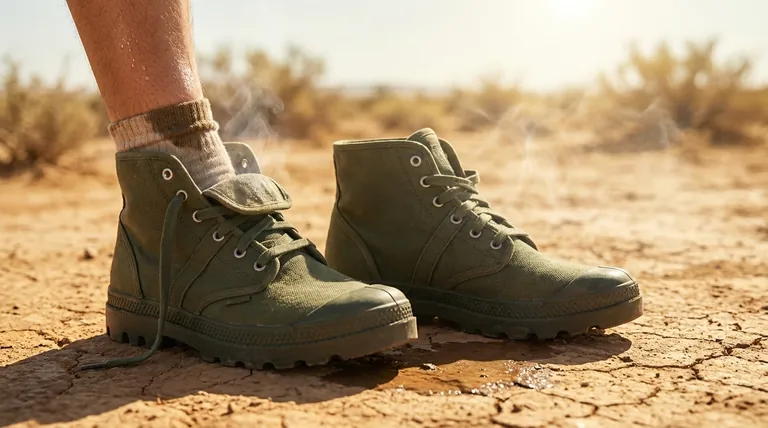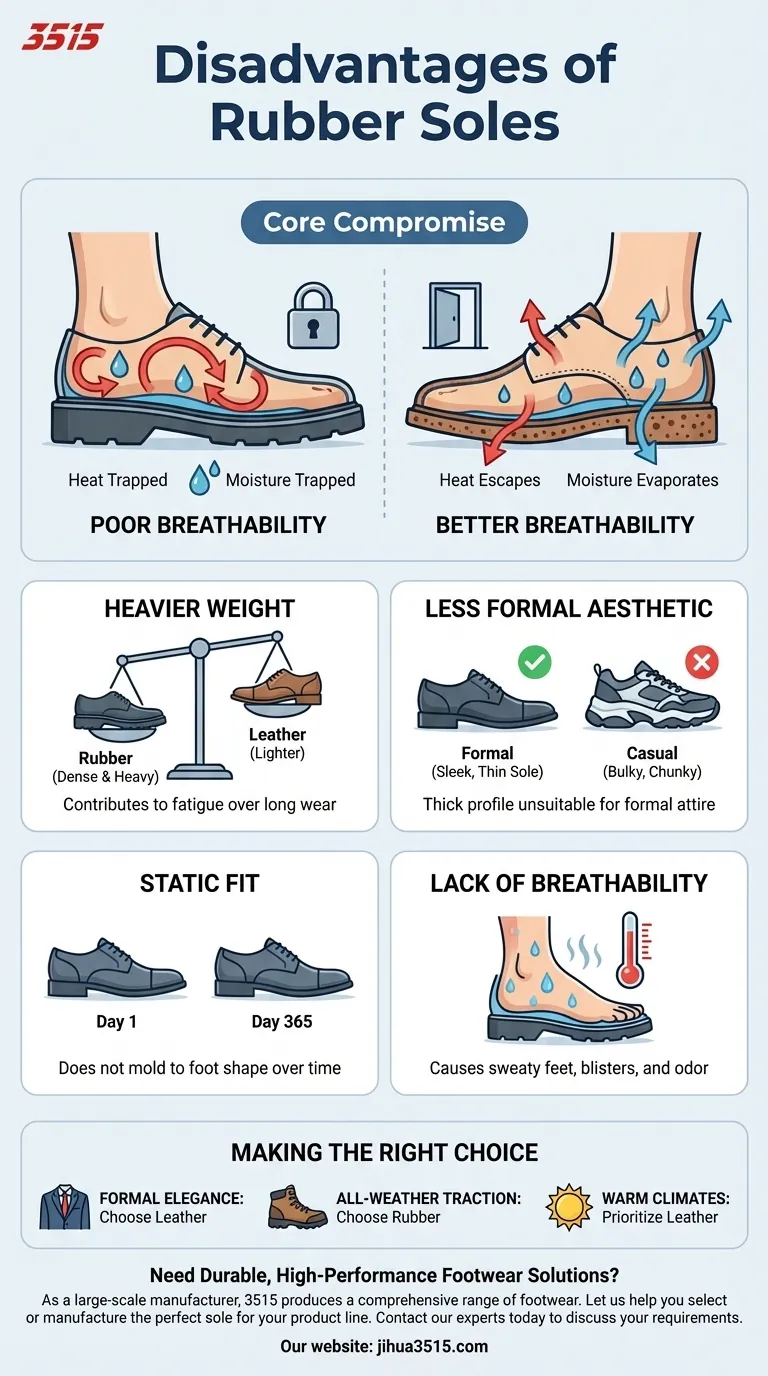The primary disadvantages of rubber soles are their lack of breathability, heavier weight, and a less formal aesthetic. While valued for durability, this material traps heat and moisture more than natural alternatives like leather. This makes the choice of a sole material a critical decision based on occasion, climate, and personal comfort.
While rubber soles offer unmatched durability and traction for casual and outdoor use, they sacrifice the breathability, custom-molding comfort, and formal elegance found in materials like leather. Understanding this core trade-off is the key to choosing the right shoe.

The Core Compromise: Breathability and Heat
A shoe's ability to manage heat and moisture is fundamental to its comfort, and this is where rubber soles present their most significant drawback.
Why Rubber Traps Moisture
Rubber is a non-porous material. Unlike leather, which has natural pores that allow air and moisture to pass through, rubber creates a solid barrier.
This lack of ventilation means that heat and sweat generated by your feet have nowhere to escape, leading to a warm and damp internal environment.
The Impact on All-Day Comfort
The direct result of poor breathability is discomfort. Trapped moisture can lead to sweaty feet, which increases the potential for blisters and foot odor over long periods of wear.
In warm or humid climates, this effect is magnified, making rubber-soled shoes feel hot and uncomfortable for extended use.
Aesthetics and Formality
Beyond physical comfort, the choice of sole material has a major impact on the visual style and appropriateness of footwear for different occasions.
The Casual Appearance
Rubber soles often have a thicker, chunkier profile. This construction is excellent for providing grip and absorbing shock, but it lends a distinctly casual or utilitarian look to a shoe.
This makes rubber the standard for sneakers, work boots, and hiking shoes, where performance is prioritized over sleekness.
The Formal Wear Divide
For formal or business settings, a slim and refined silhouette is key. Leather soles provide this elegance, creating clean lines that complement a suit or dress shoe.
A thick rubber sole on a formal shoe can appear out of place, disrupting the intended aesthetic and signaling a less formal style. While some hybrid dress shoes exist, they are always a compromise on formality.
Understanding the Trade-offs
Choosing a sole is never about finding a "perfect" material, but about understanding which set of compromises best suits your needs. Rubber's strengths in one area directly create its weaknesses in another.
The Weight Factor
The density that makes rubber incredibly durable and abrasion-resistant also makes it heavier than alternatives like leather or modern foam compounds.
While this weight difference may be negligible for short-term wear, it can contribute to fatigue over a long day or during activities that require a lot of walking.
Lack of Custom Molding
Leather soles have a unique ability to gradually mold to the specific shape of your foot over time, creating a near-custom fit.
Rubber soles are static. They do not change shape with wear, meaning the fit you get on day one is the fit you will have for the life of the shoe, offering less personalized comfort.
Where Rubber Excels
It is critical to acknowledge why rubber is so common. It provides exceptional traction on wet and uneven surfaces, is highly water-resistant, and offers superior durability and low maintenance compared to almost any other material.
Making the Right Choice for Your Goal
Ultimately, the right sole depends entirely on its intended purpose. Use these guidelines to make a clear decision.
- If your primary focus is formal elegance or a custom fit: A leather sole is the superior choice, as it offers a sleek profile and will mold to your foot over time.
- If your primary focus is all-weather traction and durability: Rubber is unmatched for its grip, water resistance, and ability to withstand abrasion, making it ideal for daily or outdoor wear.
- If your primary focus is breathability in warm climates: Prioritize leather soles to prevent the heat and moisture buildup common with rubber.
By understanding these fundamental trade-offs, you can select a sole that perfectly aligns with both the occasion and your comfort.
Summary Table:
| Disadvantage | Key Impact |
|---|---|
| Lack of Breathability | Traps heat and moisture, leading to sweaty feet and discomfort. |
| Heavier Weight | Can contribute to fatigue during long periods of wear. |
| Less Formal Aesthetic | Thicker profile is less suitable for formal or business attire. |
| Static Fit | Does not mold to the foot over time like leather soles. |
Need Durable, High-Performance Footwear Solutions?
As a large-scale manufacturer, 3515 produces a comprehensive range of footwear for distributors, brand owners, and bulk clients. Our production capabilities encompass all types of shoes and boots, allowing us to expertly balance material properties like durability, weight, and breathability to meet your specific market needs.
Let us help you select or manufacture the perfect sole for your product line.
Contact our experts today to discuss your requirements and leverage our manufacturing expertise.
Visual Guide

Related Products
- Factory-Direct Wholesale Canvas Boots with High-Traction Rubber Soles
- Wholesale Leather Work Boots with Customizable Wedge Sole for Brands
- Factory Direct Wholesale Rain Boots Durable Waterproof & Fully Customizable
- Wholesale Leather Ankle Boots with Lug Soles for Custom Brand Manufacturing
- Premium Flame-Retardant Waterproof Safety Boots and Shoes
People Also Ask
- What role do slip-resistant rubber materials play in safety shoes? Ensuring Grip and Stability in Hazardous Workplaces
- What should be avoided when storing boots with outsoles? Protect Your Investment from Dry Rot & Decay
- Why is rubber a popular material for shoe soles? Unbeatable Grip, Durability & Value
- Why is rubber commonly used for non-slip soles? The Science of Superior Grip
- What types of work environments are hiker-style rubber outsoles best for? Ideal for Outdoor & Industrial Safety



















